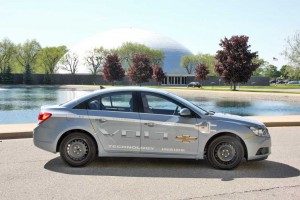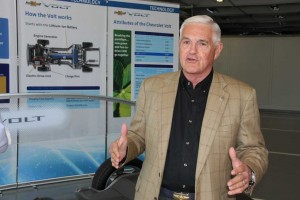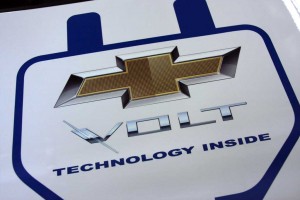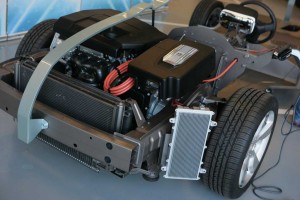
GM is just finishing early development work of the Voltec powertrain in a Chevy Cruze "mule."
“It’s already running,” says Tony Posawatz, as we walk over to the small, white sedan parked in the corner of the General Motors Design Center’s garage. And, indeed, the gauges on the dashboard of the little Chevrolet Cruze advise me that all I need do is buckle up and slip it into gear.
Of course, I had a bit of a clue when I first spotted the car, with the big “Volt” decal on its hood. In industry parlance, it’s a “mule,” a donor vehicle that, in this case, has had its conventional powertrain ripped out and replaced with the motive components of a Chevrolet Volt, the eagerly-awaited plug-in hybrid that General Motors promises to bring to market in November 2010.
Okay, let’s be a little more precise, rather than face the wrathful call of Bob Lutz, the semi-retired GM “car czar” and godfather of the Volt program, who is putting in a brief appearance before I shift into gear. Volt is better described as an “extended-range electric vehicle,” or EREV. That’s because it will run primarily on battery power. When the Lithium-Ion, or LIon, pack runs down, an inline-four gasoline engine will fire up, giving the car essentially unlimited range. But unlike, say, the planned Toyota Prius plug-in, that I-4 engine will never actually drive the wheels; it will only serve as a generator, providing power to the electric motors that give the car traction.
 As I pull out of the garage, I’m struck first by something missing. Sound. There’s only the faintest whine from the electric motor and, as I pick up speed, the sound of tires on pavement and a bit of wind. Engineers call it the “stumps-in-the-swamp” syndrome. Take away the noisy internal combustion engine and suddenly you hear everything else: tires, wind, pumps and pulleys. But GM engineers have done a surprisingly good job masking most of that noise and, promises Posawatz, head of the Volt program, we’ll hear even less when the production Volt is ready — later this month, in fact, when the first of about 75 working prototypes of the actual sedan begin to roll out. It’s a good excuse to come back for a follow-up drive.
As I pull out of the garage, I’m struck first by something missing. Sound. There’s only the faintest whine from the electric motor and, as I pick up speed, the sound of tires on pavement and a bit of wind. Engineers call it the “stumps-in-the-swamp” syndrome. Take away the noisy internal combustion engine and suddenly you hear everything else: tires, wind, pumps and pulleys. But GM engineers have done a surprisingly good job masking most of that noise and, promises Posawatz, head of the Volt program, we’ll hear even less when the production Volt is ready — later this month, in fact, when the first of about 75 working prototypes of the actual sedan begin to roll out. It’s a good excuse to come back for a follow-up drive.

"Mileage may vary," but should average at least 40 miles per charge, says semi-retired Bob Lutz.
In mule form, the Cruze I’m driving weighs about 700 pounds more than a production Volt is expected to weigh in at. That includes about 400 extra pounds of batteries needed to haul around the bigger Cruze – and counter the fact that the conventional Chevy’s body has not been aerodynamically tuned the way Volt has been. In the development phase, GM claims that subtle tweaks to the body have improved Volt’s battery-only range from about 36 miles per charge to an anticipated 40.
Of course, “your individual mileage may vary,” cautions Lutz. Use the Volt on a hot summer day, stuck in Los Angeles traffic, with its electric A/C system working, and you could lost 10% to 15% of that range. The same when you’re running your electric heater on a cold Michigan morning.
This particular, slightly warm afternoon, we’re not going to get to test that range, with or without air conditioning. We’ve got time for some loops, bobs and weaves through the sprawling GM Technical Center, in the Detroit suburb of Warren, where most of the Volt program is centered, and rumored future home of GM’s corporate offices .Nonetheless, that’s enough to get a sense of how the electric drive half of the “Voltec” drivetrain works. The gas engine has, for now, been disabled.
Coming to a stoplight, I slip the shifter into what could be called “Extreme Braking” mode – what the current Prius labels “B” mode. I stomp on the throttle and am pleasantly surprised when I feel myself lurch back into the seat padding.

Intel Inside? No, the prototype Volt driveline.
Those who know Lutz were initially a bit surprised to find his strong support for battery propulsion, but as he explained, electric motors develop maximum torque when they first start turning, which is why the Tesla Roadster can do 0 to 60 times of just 3.9 seconds.
(For an update on today’s news that Daimler is buying a 10% stake in Tesla, Click Here.)
To preserve range, GM engineers are holding performance to about 9 seconds, 0 to 60, and the Kruze mule came in a second slower. But this is no stone pony, and promoting its reasonable performance will be part of GM’s sales campaign.
Letting up on the throttle, the Volt mule slows nearly as quickly as it launched. Like a conventional gas-electric hybrid, the production Volt will use regenerative braking to recapture energy normally lost during coasting and braking, turning it back into electricity and recharging the battery. B-mode ratchets regeneration up a couple notches, and feels much like downshifting several gears.

Like a conventional hybrid, Volt will pair a battery and electric motor with a gasoline engine, but here, the small I-4 will only be used to generate electricity when Volt's battery runs down.
The key takeaway from this brief drive is that the Voltec drive system, the electric half, anyway, seems darn close to ready for prime time, which given the production of GM’s EV1 electric car of a decade ago, is not surprising. How it integrates into the actual, highly aerodynamic Volt body remains to be seen, as does the performance and behavior of the car’s back-up generator/gasoline engine. But “We’re now totally confident about the technology,” insists Posawatz.
The engineering team has about 18 months left to work out the bugs. And they’re already gathering a list of things they can do differently in what Silicon Valley folks like to call “Gen 2.0”.
“We think there’s thousands of dollars that can come out of this car,” says Posawatz, as we pull back into the Design garage, which is a good thing since competing hybrids form Honad and Toyota are already on sale in the $20-$30,000 range. The charger alone, he suggests, is costing GM about three times more than it should when it can source the system from a high-volume supplier, rather than borrowing a system developed for recharging golf carts. The initial system, incidentally, will take less than 3 hours with 220 volt current, closer to 8 hours on the 110 volts in your house.
Then there’s the battery. There’s little doubt this is both the heart and the potential Achilles’ Heel of the electric vehicle movement. LIon technology has proved itself in consumer electronics, but whether it will hold up, long-term in the highly demanding automotive environment remains to be seen. That is why, “We’re sticking with nickel-metal hydride technology, at least for now,” Mark Templin, general manager of Toyota’s Lexus division told me, last week, during a preview of the highline brand’s new HS250h hybrid.
Lutz and Posawatz both insist they’re comfortable with the version of LIon battery technology being used by their partner/supplier, South Korea’s LG Chem. But they’re also doing everything they can to make sure the Volt’s batteries will last for a minimum 10 years or 100,000 miles. There’s a costly climate control system to keep it at an ideal operating temperature, and in operation, the battery will only be charged to a maximum 80% of capacity and discharged to no lower than 30%.
Longer-term, says Posawatz, they could draw even deeper, if the early Volts perform well. Meanwhile, just as with nickel-metal technology, lithium batteries are fast improving and steadily increasing their charge capacity or, if you prefer, energy density. Within a couple years, GM hopes to be able to use smaller, lighter batteries to get the same range, which could add up to hundreds of dollars in additional savings. We treat such battery advancement claims, which have been made for decades, with fa air amount of skepticism.
While the automaker hasn’t set a final price for Volt, it’s unlikely to subsidize the sedan, at least to any great degree, considering its current financial problems. So a sticker price of somewhere between $35,000 and $40,000 seems likely, according to well-placed sources. But the vehicle should qualify for a $7,500 federal tax credit, and possibly other state and local tax breaks. The Treasury Department’s Auto Task Force has already declared the vehicle a loser because of its high projected price.
Meanwhile, GM is working to set up alliances with various electric utilities around the country. The 220v charging system is a “smart” device that could be set to operate at a particular hour, or to charge only when the utility company has a surplus of energy and would charge the least. In fact, says Posawatz, “some utilities might want to offer you a year’s free power” for recharging if you agree only to recharge at such times.
In turn, GM – and other companies pushing electrification – is exploring other ways to hold down costs. A car plugged into a smart charger during a brown-out, for example, could be tapped for its stored energy. And after the anticipated 10-year lifecycle of a Volt battery, GM research projects the pack will still maintain as much as 70% of its initial capacity. A number of experts are calling for the creation of a back-up power grid using such cast-off batteries. That would prove particularly helpful with leveling out the energy provided by solar, wind and other renewable but irregular power sources.
For the moment, that’s all grand theory from a company that is about to declare bankruptcy, but if our brief drive of the Volt mule is any indication, there’s reason to hope that the plug-in, er, extended-range electric vehicle really will live up to its hefty advanced promotion. Whether that will be enough to turn on consumers, however, remains to be seen. It will help, Posawatz concedes, if fuel prices start climbing again — as they now seem to be doing. At $3.50 a gallon, GM is betting it could see strong demand. At $2.00 a gallon, well, Volt might turn into an answer to a question nobody will be asking.
